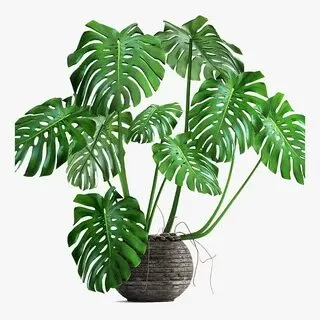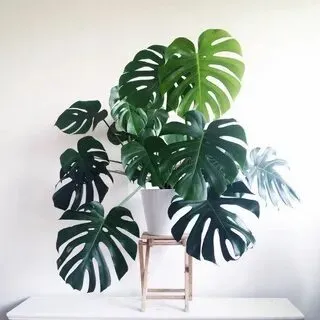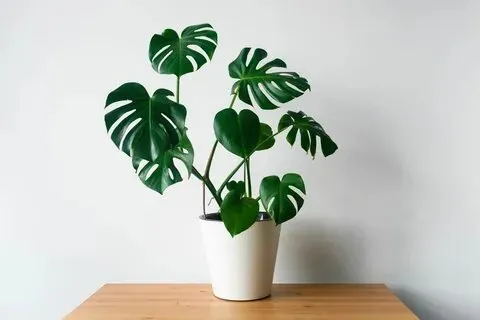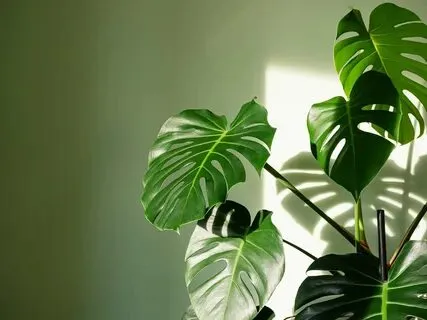Monstera Plants
What are Monstera Plants?
Monstera plants, often known as the “Swiss cheese plant” due to their unique leaf holes, are a genus of around 50 species of flowering plants in the arum family, Araceae. Originating from the tropical regions of Central and South America, these plants are cherished for their distinctive, perforated leaves and vigorous growth. The name “Monstera” comes from the Latin word for “monstrous” or “abnormal,” referring to the unusual and dramatic leaf shapes.
History and Origin
The history of Monstera plants dates back to their native habitats in the dense tropical rainforests. They were first discovered in the wild regions of southern Mexico to Panama. Indigenous peoples used various parts of the plant for medicinal purposes and as a food source, primarily consuming the fruit of Monstera deliciosa, which is edible when ripe.
Varieties of Monstera Plants

Monstera plants come in several varieties, each with unique characteristics:
- Monstera deliciosa: Known for its large, split leaves and edible fruit.
- Monstera adansonii: Features smaller leaves with a series of oval holes.
- Monstera obliqua: Rare and highly sought after, with extremely delicate leaves.
- Monstera dubia: Notable for its shingling habit as a juvenile plant.
Understanding these varieties helps plant enthusiasts choose the right Monstera for their home or garden.
Benefits of Monstera Plants

Aesthetic Appeal
Monstera plants are highly prized for their dramatic and aesthetically pleasing foliage. The large, fenestrated leaves can make a striking visual statement in any indoor space. Their unique appearance complements various interior design styles, from minimalist to bohemian.
Air Purification
Like many indoor plants, Monstera plants contribute to air purification. They can absorb pollutants and toxins such as formaldehyde and benzene, improving indoor air quality. This makes them an excellent addition to homes and offices.
Psychological Benefits
Caring for Monstera plants can have several psychological benefits. Studies have shown that interacting with plants can reduce stress levels, enhance mood, and improve overall mental well-being. The act of nurturing a plant can provide a sense of accomplishment and connection to nature.
Understanding Monstera Plant Anatomy

Leaves
The leaves of Monstera plants are their most distinctive feature. They start as solid, heart-shaped leaves and develop holes or splits as they mature. This fenestration is thought to help the plant withstand heavy rain and wind in its natural habitat.
Stems
Monstera stems are thick and sturdy, capable of supporting the large leaves. They also have aerial roots that help the plant climb and anchor to surfaces in the wild. These roots can be used in propagation as well.
Roots
The root system of a Monstera plant includes both underground roots that absorb nutrients and water, and aerial roots that provide support. Proper root health is essential for the overall well-being of the plant.
Ideal Growing Conditions

Light Requirements
Monstera plants thrive in bright, indirect light. They can tolerate lower light conditions but may not grow as vigorously. Direct sunlight can scorch the leaves, so it’s best to place them near a window with filtered light.
Temperature and Humidity
These tropical plants prefer warm, humid environments. Ideal temperatures range from 65-85°F (18-29°C). Higher humidity levels mimic their natural rainforest habitat and promote healthy growth. In drier climates, using a humidifier can be beneficial.
Soil Preferences
Well-draining soil is crucial for Monstera plants. A mix of potting soil, peat moss, and perlite provides the right balance of nutrients and drainage. Avoid heavy, clayey soils that retain too much moisture.
Planting Monstera Plants
Choosing the Right Pot
Selecting the right pot is important for the health of your Monstera. Pots with drainage holes prevent water from accumulating at the bottom, reducing the risk of root rot. The size of the pot should allow room for growth but not be excessively large.
Soil Preparation
Preparing the soil mix involves combining equal parts potting soil, peat moss, and perlite. This mix ensures good drainage and retains enough moisture for the plant’s needs. Adding a bit of compost can enhance nutrient availability.
Planting Techniques
When planting a Monstera, gently loosen the roots and place the plant in the center of the pot. Fill around the roots with the prepared soil mix, pressing lightly to eliminate air pockets. Water thoroughly after planting to settle the soil.
Watering Monstera Plants
Watering Frequency
Monstera plants prefer to dry out slightly between waterings. A general rule is to water when the top inch of soil feels dry to the touch. Overwatering can lead to root rot, while underwatering can cause the leaves to droop.
Signs of Overwatering
Signs of overwatering include yellowing leaves, a musty smell from the soil, and soggy, discolored roots. If these symptoms appear, reduce watering frequency and ensure the pot has proper drainage.
Signs of Underwatering
Underwatered Monstera plants will have drooping leaves, dry soil, and possibly browning leaf edges. Increasing the watering frequency and checking the soil moisture regularly can help address this issue.
Fertilizing Monstera Plants
Types of Fertilizers
Balanced, water-soluble fertilizers are ideal for Monstera plants. A 20-20-20 NPK (nitrogen, phosphorus, potassium) ratio works well. Organic options like compost tea or fish emulsion can also be beneficial.
How Often to Fertilize
Fertilizing every 4-6 weeks during the growing season (spring and summer) supports healthy growth. Reduce or stop fertilizing in the fall and winter when the plant’s growth slows down.
Signs of Nutrient Deficiency
Nutrient deficiencies in Monstera plants can manifest as yellowing leaves, stunted growth, or pale foliage. Regular fertilization and using a balanced nutrient mix can prevent these issues.
Pruning and Maintenance

How to Prune Monstera Plants
Pruning helps control the size and shape of Monstera plants. Use clean, sharp scissors or pruning shears to remove dead or damaged leaves. Trimming back overgrown stems can also encourage fuller growth.
Managing Pests and Diseases
Common pests include spider mites, mealybugs, and scale insects. Regularly inspecting the plant and using insecticidal soap or neem oil can help manage infestations. Fungal diseases can be prevented by avoiding overwatering and ensuring good air circulation.
Cleaning and Dusting Leaves
Dust can accumulate on Monstera leaves, inhibiting photosynthesis. Wipe the leaves with a damp cloth or give the plant a gentle shower to keep them clean and healthy.
Propagating Monstera Plants

Propagation by Cuttings
Propagation by cuttings is a popular method. Cut a healthy stem with at least one node and a few leaves. Place the cutting in water or moist soil, and roots will develop in a few weeks.
Air Layering Method
Air layering involves making a small cut in a stem and wrapping it with moist sphagnum moss. Once roots form, the stem can be cut and planted separately. This method is more advanced but often yields better results.
Common Mistakes in Propagation
Common mistakes include using unhealthy cuttings, not providing enough humidity, and overwatering. Ensuring proper care and conditions increases the success rate of propagation efforts.
Troubleshooting Common Problems

Yellow Leaves
Yellow leaves can indicate overwatering, underwatering, or nutrient deficiencies. Assess the watering schedule, check soil moisture, and ensure regular fertilization to address this issue.
Brown Leaf Tips
Brown leaf tips are often a sign of low humidity or over-fertilization. Increasing humidity with a humidifier and flushing the soil to remove excess salts can help.
Leggy Growth
Leggy growth occurs when a Monstera plant stretches towards light, resulting in long, spindly stems. Providing adequate light and rotating the plant regularly can encourage more balanced growth.
Repotting Monstera Plants
When to Repot
Repotting is typically needed every 1-2 years, or when the plant outgrows its pot. Signs include roots growing out of drainage holes or the plant becoming top-heavy.
Steps for Repotting
Repotting involves gently removing the plant from its current pot, loosening the roots, and placing it in a larger pot with fresh soil. Water thoroughly after repotting to help the plant settle in its new home.
Post-Repotting Care
Post-repotting care includes keeping the plant in a stable environment, avoiding direct sunlight, and watering lightly until it adjusts. Monitoring for any signs of stress can help ensure a smooth transition.
Seasonal Care for Monstera Plants

Spring Care
Spring is the growing season for Monstera plants. Increase watering, start regular fertilization, and consider repotting if necessary. Pruning can also help shape the plant for the upcoming growth.
Summer Care
Summer care involves maintaining consistent watering and humidity levels. Monitor for pests and provide support for any new growth. Outdoor placement in a shaded area can be beneficial.
Fall Care
In the fall, gradually reduce watering and fertilization as the plant’s growth slows. Preparing for the lower light levels of winter is crucial, so consider moving the plant to a brighter spot if necessary.
Winter Care
Winter care focuses on minimizing watering and avoiding cold drafts. Using a humidifier can counteract dry indoor air, and additional lighting may be needed to support the plant’s health.
Decorating with Monstera Plants

Indoor Decor Ideas
Monstera plants can be a stunning centerpiece in living rooms, offices, or bathrooms. Placing them in decorative pots and pairing them with complementary furniture can enhance the aesthetic appeal of any space.
Outdoor Landscaping
In tropical or subtropical climates, Monstera plants can be used in outdoor landscaping. They can create a lush, exotic look in gardens or patios when planted in the ground or large containers.
Pairing with Other Plants
Pairing Monstera plants with other tropical plants like philodendrons, ferns, or palms can create a cohesive and vibrant plant display. Choosing plants with similar care requirements ensures harmonious growth.
Monstera Plants in Popular Culture
Monstera in Art and Design
Monstera plants have inspired many artists and designers. Their unique leaves are often depicted in prints, wallpapers, and textiles, adding a tropical flair to various artistic creations.
Monstera in Social Media Trends
Social media platforms, especially Instagram and Pinterest, are flooded with images of Monstera plants. They have become a symbol of urban jungle aesthetics and are frequently featured in home decor inspiration posts.
Monstera in Literature
Monstera plants have also made appearances in literature, symbolizing growth, beauty, and resilience. They are often mentioned in botanical books and gardening guides.
Conclusion
Monstera plants are versatile, aesthetically pleasing, and relatively easy to care for. Understanding their needs and providing the right conditions can help them thrive and enhance any living space.
Whether you’re a seasoned plant enthusiast or a beginner, Monstera plants offer a rewarding and visually striking addition to your home. Start growing a Monstera today and enjoy the numerous benefits these remarkable plants bring.
